Intro
Discover Von Willebrand Disease symptoms, causes, and treatment options, including bleeding disorders, clotting issues, and diagnostic tests, to manage this common blood disorder effectively.
Von Willebrand disease (VWD) is a common inherited bleeding disorder that affects millions of people worldwide. It is caused by a deficiency or dysfunction of the von Willebrand factor (VWF), a protein that plays a crucial role in blood clotting. The symptoms of VWD can vary widely in severity and impact, making it essential to understand the signs and manifestations of this condition. In this article, we will delve into the world of VWD, exploring its symptoms, causes, diagnosis, treatment, and management options.
The importance of recognizing VWD symptoms cannot be overstated. Early detection and proper management can significantly improve the quality of life for individuals with this condition. VWD can affect anyone, regardless of age, sex, or ethnicity, and its symptoms can be mild, moderate, or severe. By understanding the signs and symptoms of VWD, individuals can seek medical attention promptly, reducing the risk of complications and improving overall health outcomes.
VWD is often referred to as a "hidden" disorder, as its symptoms can be subtle and may not always be immediately apparent. However, by being aware of the common signs and symptoms of VWD, individuals can take proactive steps to manage their condition and prevent complications. In the following sections, we will explore the various aspects of VWD, including its causes, diagnosis, treatment, and management options, as well as provide practical tips and advice for individuals living with this condition.
Von Willebrand Disease Symptoms
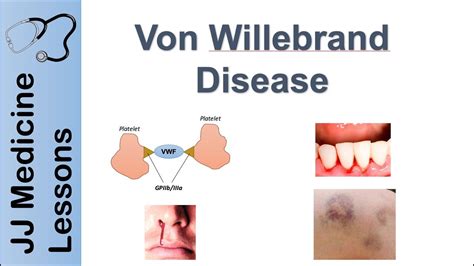
The symptoms of VWD can vary widely in severity and impact, ranging from mild to severe. Common symptoms include easy bruising, nosebleeds, heavy menstrual bleeding, and bleeding gums. In more severe cases, VWD can cause bleeding into joints or muscles, which can lead to pain, swelling, and limited mobility. Some individuals with VWD may experience no symptoms at all, while others may experience frequent or severe bleeding episodes.
Common Symptoms of Von Willebrand Disease
Some common symptoms of VWD include: * Easy bruising * Nosebleeds * Heavy menstrual bleeding * Bleeding gums * Bleeding into joints or muscles * Prolonged bleeding after injury or surgery * Heavy bleeding during childbirth or after deliveryCauses and Risk Factors of Von Willebrand Disease
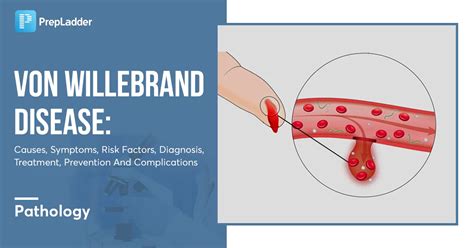
VWD is caused by a deficiency or dysfunction of the VWF, which is a protein that plays a crucial role in blood clotting. The VWF is produced by endothelial cells and megakaryocytes, and it helps to facilitate platelet adhesion and aggregation at the site of injury. In individuals with VWD, the VWF is either absent or defective, leading to impaired blood clotting and increased bleeding risk.
Risk Factors for Von Willebrand Disease
Some risk factors for VWD include: * Family history of VWD * Female sex * Age (symptoms may worsen with age) * Other bleeding disorders (e.g., hemophilia) * Certain medications (e.g., aspirin, nonsteroidal anti-inflammatory drugs)Diagnosis and Testing for Von Willebrand Disease
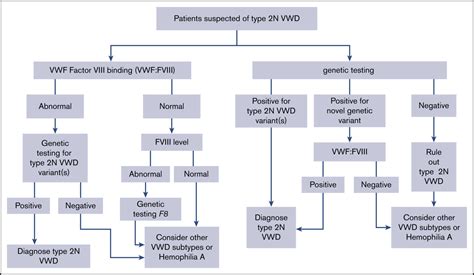
Diagnosing VWD can be challenging, as its symptoms can be similar to those of other bleeding disorders. A diagnosis of VWD is typically made based on a combination of clinical evaluation, laboratory tests, and medical history. Laboratory tests may include:
- VWF antigen assay
- VWF activity assay (e.g., ristocetin cofactor activity)
- Factor VIII activity assay
- Bleeding time test
- Platelet function test
Diagnostic Criteria for Von Willebrand Disease
The diagnostic criteria for VWD include: * Low VWF levels (<30 IU/dL) * Low VWF activity (<30 IU/dL) * Prolonged bleeding time (>10 minutes) * Positive family history of VWD * Clinical symptoms consistent with VWD (e.g., easy bruising, nosebleeds)Treatment and Management Options for Von Willebrand Disease
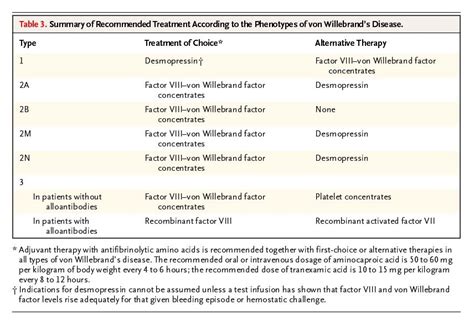
The treatment and management of VWD depend on the severity of symptoms and the individual's overall health status. Treatment options may include:
- Desmopressin (DDAVP) to increase VWF levels
- VWF replacement therapy (e.g., Humate-P, Wilate)
- Factor VIII concentrates
- Antifibrinolytic agents (e.g., tranexamic acid)
- Hormonal therapies (e.g., birth control pills) to reduce menstrual bleeding
Self-Care and Lifestyle Modifications for Von Willebrand Disease
Some self-care and lifestyle modifications that can help manage VWD include: * Avoiding contact sports and activities that may increase bleeding risk * Using protective gear (e.g., helmets, knee pads) during sports and activities * Avoiding certain medications (e.g., aspirin, nonsteroidal anti-inflammatory drugs) * Maintaining good oral hygiene to prevent bleeding gums * Using a soft toothbrush and gentle toothpaste to reduce bleeding riskComplications and Prognosis of Von Willebrand Disease
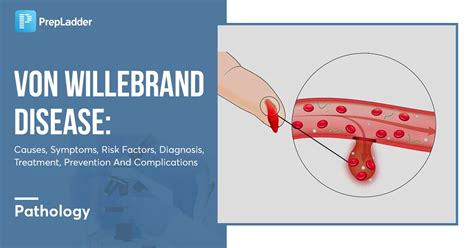
If left untreated or undertreated, VWD can lead to significant complications, including:
- Severe bleeding episodes
- Joint damage and disability
- Menstrual bleeding disorders
- Pregnancy complications
- Increased risk of infection and sepsis
Prognosis and Quality of Life for Von Willebrand Disease
The prognosis for VWD is generally good, especially with proper treatment and management. However, the quality of life for individuals with VWD can be significantly impacted by the severity of symptoms and the effectiveness of treatment. With advances in diagnosis and treatment, many individuals with VWD can lead active and fulfilling lives, with minimal disruption from their condition.Current Research and Future Directions for Von Willebrand Disease
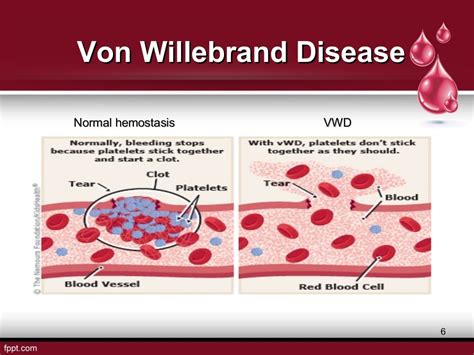
Current research in VWD is focused on improving diagnosis, treatment, and management options for individuals with this condition. Some areas of research include:
- Developing new and more effective treatments for VWD (e.g., gene therapy, recombinant VWF)
- Improving diagnostic tests and criteria for VWD
- Investigating the role of VWF in other diseases and conditions (e.g., cardiovascular disease, cancer)
- Developing personalized treatment plans for individuals with VWD
Emerging Trends and Technologies for Von Willebrand Disease
Some emerging trends and technologies in VWD research include: * Gene editing and gene therapy * Recombinant VWF and other novel therapeutics * Point-of-care diagnostic tests and devices * Telehealth and remote monitoring technologiesWhat is von Willebrand disease?
+Von Willebrand disease is a common inherited bleeding disorder caused by a deficiency or dysfunction of the von Willebrand factor, a protein that plays a crucial role in blood clotting.
What are the symptoms of von Willebrand disease?
+The symptoms of VWD can vary widely in severity and impact, and may include easy bruising, nosebleeds, heavy menstrual bleeding, and bleeding gums.
How is von Willebrand disease diagnosed?
+A diagnosis of VWD is typically made based on a combination of clinical evaluation, laboratory tests, and medical history, including VWF antigen and activity assays, factor VIII activity assays, and bleeding time tests.
What are the treatment options for von Willebrand disease?
+Treatment options for VWD depend on the severity of symptoms and may include desmopressin, VWF replacement therapy, factor VIII concentrates, antifibrinolytic agents, and hormonal therapies.
Can von Willebrand disease be cured?
+While there is currently no cure for VWD, advances in diagnosis and treatment have significantly improved the quality of life for individuals with this condition, and ongoing research holds promise for future breakthroughs.
As we conclude our exploration of von Willebrand disease, we hope that this comprehensive guide has provided valuable insights and information for individuals affected by this condition, as well as their families and healthcare providers. By understanding the symptoms, causes, diagnosis, treatment, and management options for VWD, we can work together to improve health outcomes and enhance the quality of life for those living with this condition. We invite you to share your thoughts, experiences, and questions in the comments section below, and to join the conversation on social media using relevant hashtags. Together, we can raise awareness and promote greater understanding of von Willebrand disease, and support those affected by this condition.
